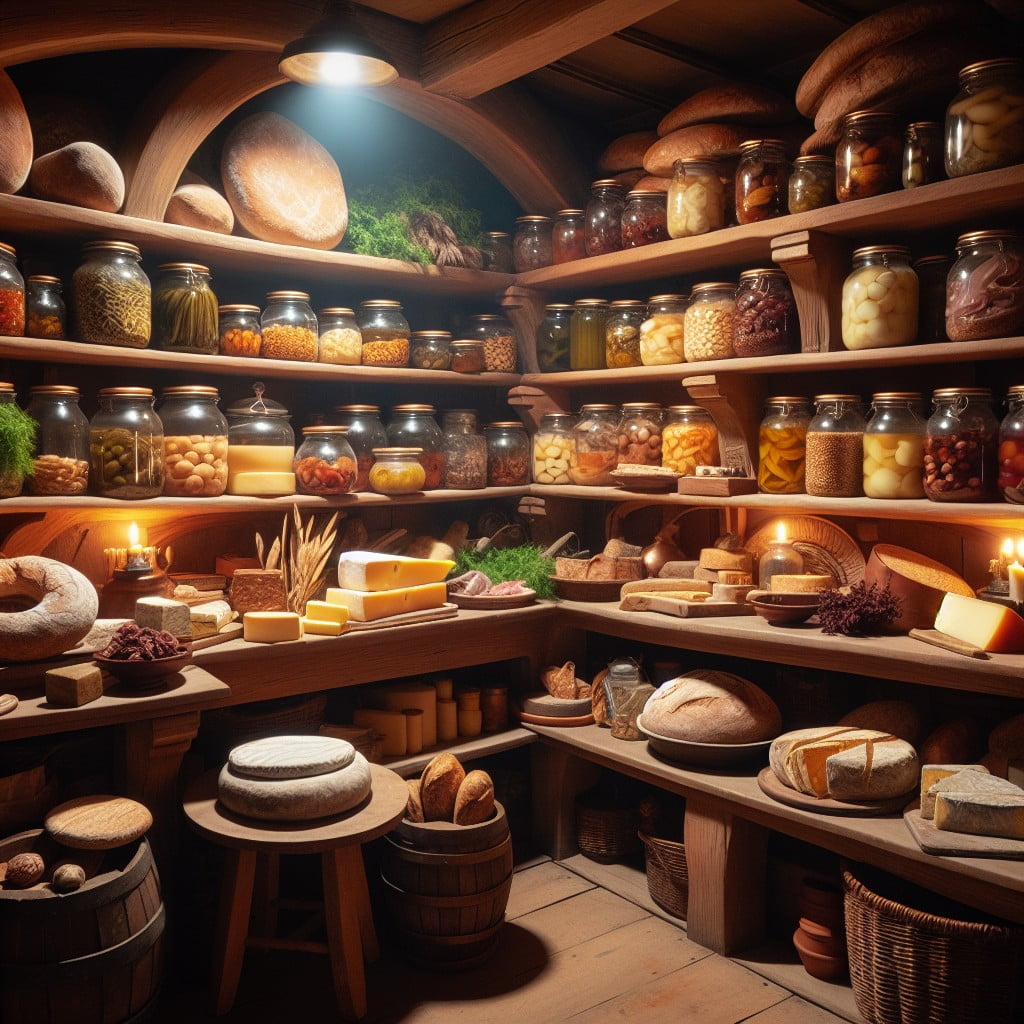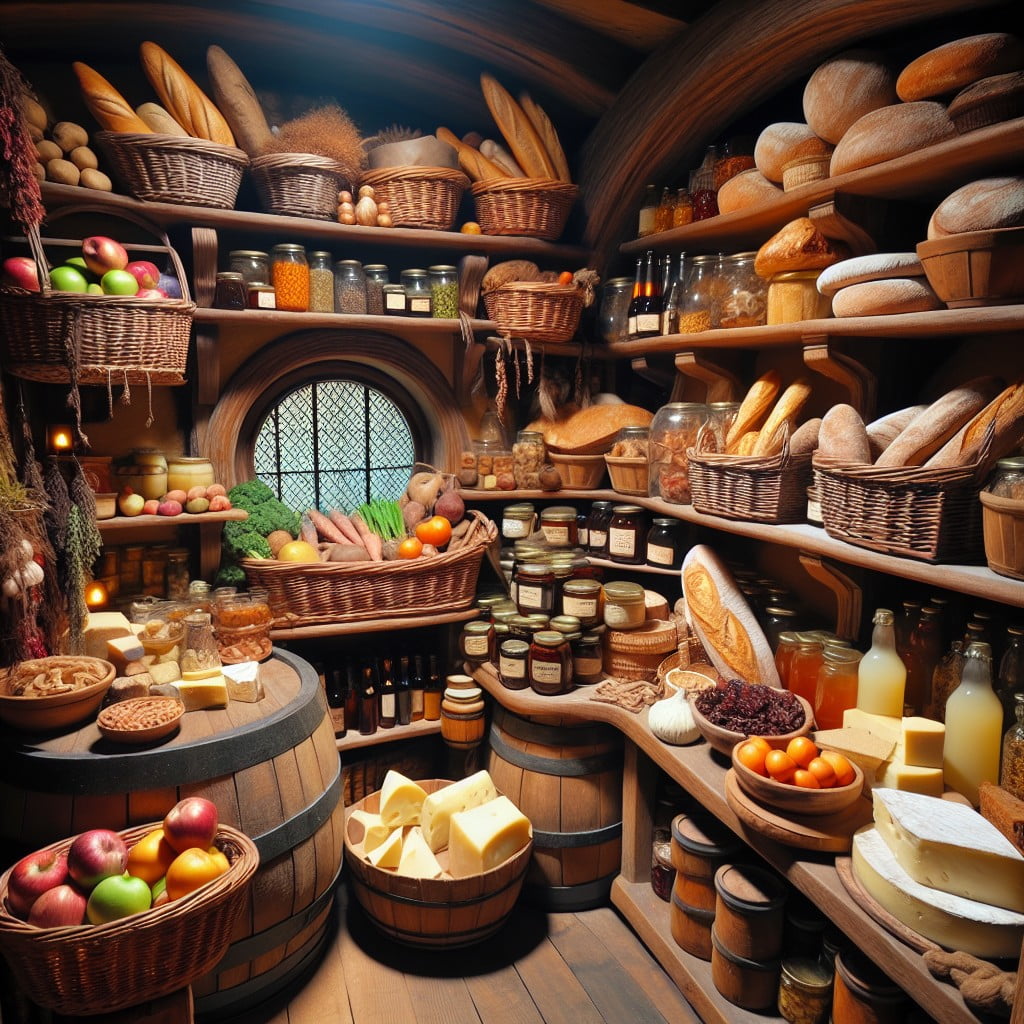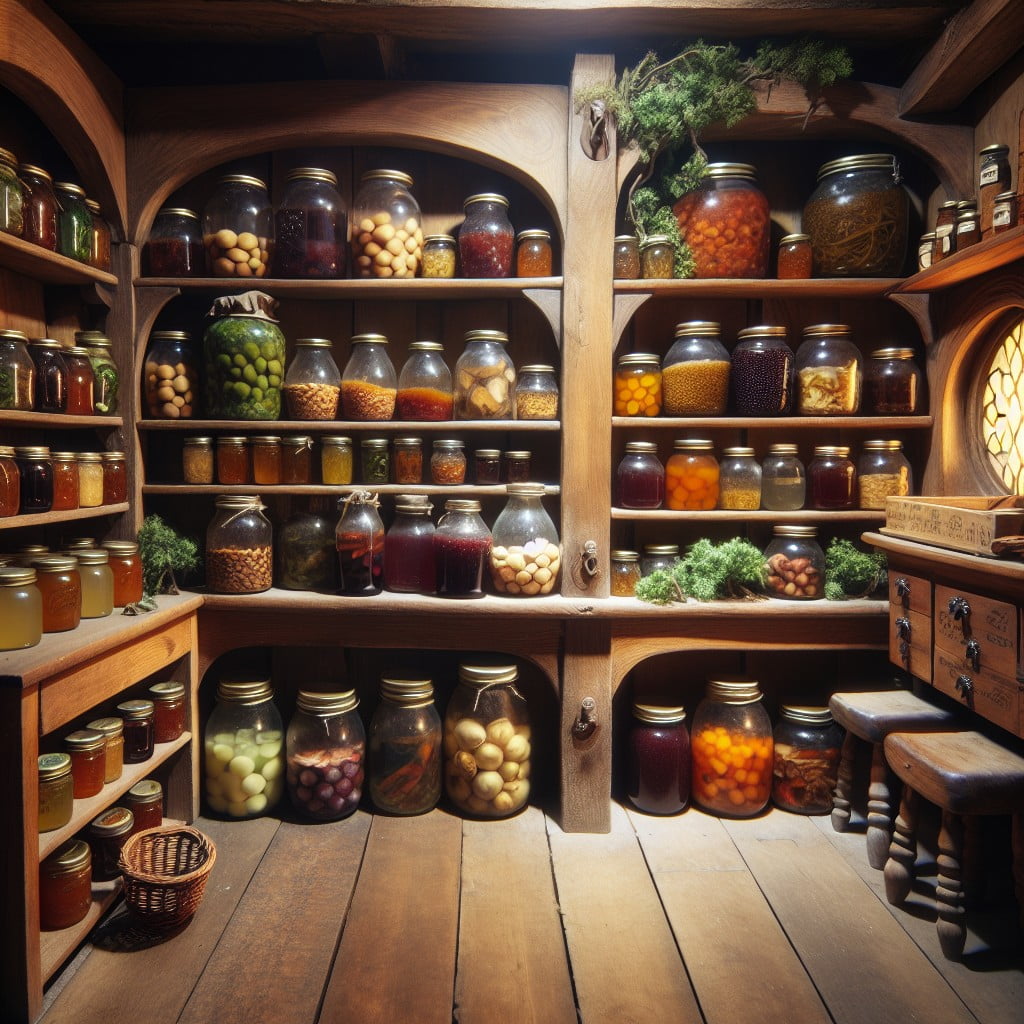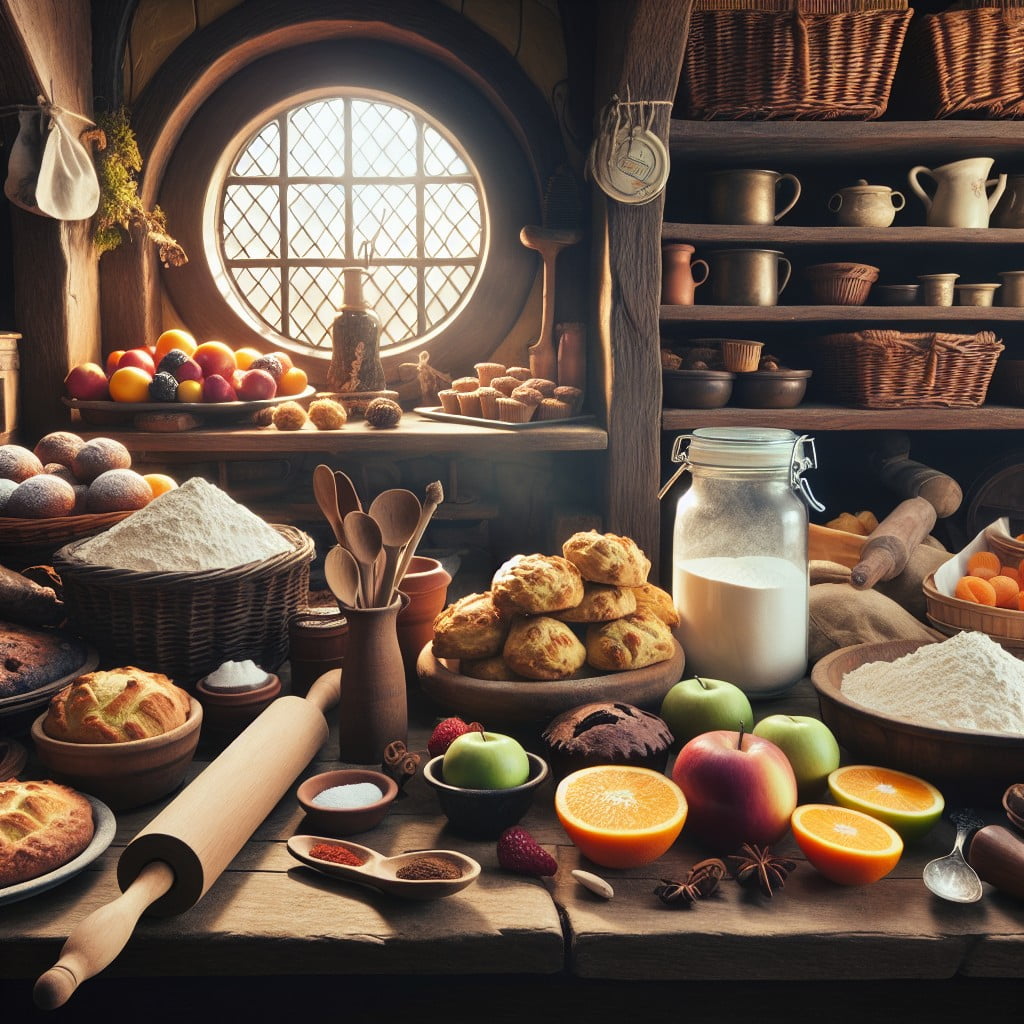Last updated on
Explore the fascinating world of hobbit-inspired recipes because each dish from the hobbit pantry uniquely combines traditional ingredients with unforgettable flavors.
Key takeaways:
- Having a well-stocked hobbit pantry ensures frequent, seasonal, and economic meals.
- Essential foods include whole grains, cured meats, cheeses, ale, pickles, root vegetables, honey, and spices.
- Canning and preserving techniques extend the shelf life of ingredients.
- Baking essentials include flour, yeast, spices, and dried fruits.
- A root cellar helps store fresh produce throughout the year.
Importance of a Well-Stocked Hobbit Pantry

A fully stocked pantry is central to hobbit life, reflecting their love of comfort and readiness for hospitality. With meals being a focal part of the day, having ingredients on hand ensures that a delicious dish can always be prepared, whether for an unexpected guest or a planned gathering.
Key points illustrating the relevance of such a pantry include:
- Frequent Meals: Hobbits enjoy multiple meals daily, so a variety of ingredients is necessary to cater to this eating schedule without frequent trips to market.
- Seasonal Readiness: A well-stocked pantry allows hobbits to have access to favorite foods year-round, despite changing seasons and availability.
- Emergency Preparedness: Should an unforeseen event occur, a pantry brimming with goods means hobbits can sustain themselves comfortably until normalcy resumes.
- Economic Sense: Buying in bulk and preserving food when it’s abundant and less expensive makes for a cost-effective household management strategy.
- Tradition and Heritage: Recipes passed down through generations require certain staples to be kept on hand, preserving culinary traditions.
In essence, the hobbit pantry is a cornerstone of their cultural affinity for good food, comfort, and economic wisdom.
Essential Foods in a Hobbit Pantry

Hobbits are known for their love of food, so a well-stocked pantry is crucial. Think of diverse, hearty ingredients that provide both comfort and nutrition.
1. Whole Grains: Essential for making bread, an everyday staple. Stock up on flour, oats, barley, and perhaps a little cornmeal for diversity in baking.
2. Cured Meats: With a penchant for savory flavors, cured meats like bacon and ham are pantry favorites, offering versatility for various meals.
3. Cheeses: A selection ranging from mild to sharp ensures there’s a perfect match for any dish or snack.
4. Ale and Wine: Beverages are as important as solids, and no hobbit pantry is complete without a few bottles of good quality ale and wine.
5. Pickles and Preserves: Jars filled with pickled vegetables and sweet fruit preserves guarantee a touch of summer flavor throughout the year.
6. Root Vegetables: Potatoes, carrots, and turnips store well, providing the base for many a nourishing stew.
7. Honey and Spices: The cornerstones for adding a touch of sweetness and depth to any hobbit dish cannot be overlooked.
This assortment is key to the hobbit’s ability to whip up spontaneous meals that are as robust as they are delicious.
Canning and Preserving Techniques

To maintain a year-round supply of flavorful ingredients, hobbits rely heavily on canning and preserving. Mason jars filled with jams, jellies, and chutneys are common sights, ensuring fruits of the harvest don’t go to waste.
The process of water bath canning is quite popular for acidic foods like tomatoes and pickles, whereby jars are submerged in boiling water to seal and preserve the contents.
For non-acidic foods, pressure canning is the method of choice, as it involves higher temperatures to prevent spoilage and bacterial growth. Drying herbs and making fruit leathers are also simple, yet effective ways of extending shelf life.
Moreover, smoking meats and fish adds a depth of flavor while keeping the pantry stocked. Airtight sealing and proper labeling with dates ensure that nothing is forgotten or lost to time. With these methods, the variety of food available in colder months is greatly expanded, providing comfort and sustenance throughout the year.
Baking Essentials for Hobbit Treats

Stocking the right ingredients is key to mastering the art of Hobbit baking. Flour, a staple, forms the base for an array of breads and pastries. Whole grains like barley and wheat flour add a rustic touch, fitting for a Hobbit’s hearty appetite. Sweeteners should not be overlooked; honey and molasses are preferred over refined sugars, offering rich, earthy flavors.
Yeast and baking powder are leavening essentials that give rise to the delectable loaves and scones enjoyed during second breakfast or elevenses. Spices such as cinnamon, nutmeg, and cloves infuse the baked goods with warmth and depth, while real butter ensures richness and a tender crumb in every bite. Lastly, a variety of dried fruits – think currants, raisins, and sultanas – along with nuts like walnuts and almonds, provide texture and bursts of flavor to any treat that comes out of a Hobbit’s oven.
For fresh ingredients, eggs and dairy must always be at hand. These not only contribute to the structure and flavor but also to the golden color of the final products. With these essentials on your shelves, the delightful aromas of baking will be a regular comfort in your home, much to the envy of your neighbors.
Root Cellar: Storage for Fresh Produce
Root cellars play a crucial role in extending the shelf life of produce without the need for modern refrigeration. These underground structures take advantage of the earth’s natural insulation, maintaining a consistent, cool temperature that helps prevent spoilage.
Here’s how they benefit a hobbit’s food storage:
- Consistent Cool Temperature: Earth-covered walls keep the cellar cool, which slows down the ripening process of fruits and vegetables.
- Humidity Control: Proper ventilation ensures the right balance of humidity, preventing the withering of roots and tubers.
- Darkness: The absence of light helps reduce the loss of nutrients and minimizes the chance of potatoes sprouting.
- Organization: Shelves and bins allow for orderly storage, making it easy to manage inventory and rotate stock.
- Seasonal Storage: Root cellars are ideal for storing harvests from late summer through winter, ensuring a supply of fresh ingredients.
By relying on these principles, a hobbit pantry ensures a year-round supply of fresh, nutritious produce ready for any meal.
Hobbit-Sized Meals and Portioning
Understanding portion sizes is crucial in the scope of hobbit dining culture. The typical hobbit meal schedule consists of breakfast, second breakfast, elevenses, luncheon, afternoon tea, dinner, and supper, which necessitates smaller, well-distributed portions throughout the day.
- Balance is key: Each meal, while smaller in size, should still contain a variety of food groups, including proteins, carbohydrates, and vegetables.
- Pre-portion ingredients: Pre-measure staples such as oats, flour, and dried fruit, to expedite the preparation of frequent small meals.
- Bite-sized snacks: Keep a selection of nuts, cheeses, and sliced fruit readily available for quick, nutritious options between main meals.
- Prioritize quality over quantity: Opt for rich, satisfying flavors that fulfill cravings in a few bites, thus supporting the hobbit tradition of savoring each meal.
- Use smaller plates: This helps in naturally controlling portion sizes and is in keeping with the modest scale of hobbit culinary culture.
- Embrace leftovers: Plan for meals that can easily be divided into smaller servings and enjoyed later, thus ensuring nothing goes to waste.
Traditional Hobbit Recipes
Hobbits are known for their love of hearty, rustic meals, which often feature ingredients readily available from their pantries. These timeless recipes emphasize simple yet flavor-rich preparations:
- Seed Cake: A favorite for tea time, this cake is packed with caraway seeds, offering a uniquely spicy flavor profile.
- Mushroom and Bacon Pie: A savory dish combining mushrooms—a hobbit staple—with rich bacon in a flaky pastry.
- Poached Pears with Cloves: A sweet treat, these pears are gently simmered with cloves and honey, highlighting preservation methods and the use of spices.
- Lamb Stew with Root Vegetables: A classic comfort food utilizing pantry-stored root veggies like carrots and potatoes, stewed with lamb in a thick, savory broth.
- Honey Cakes: Small, sweet cakes drizzled or infused with honey, exemplifying the hobbit penchant for natural sweeteners.
These recipes showcase how pantry items come together to create meals that are both satisfying and steeped in tradition.
Modern Adaptations of Hobbit Cuisine
While traditional hobbit fare is deeply rooted in the agrarian culture of the Shire, contemporary chefs and food enthusiasts have embraced the challenge of infusing modern twists into these classic dishes.
In cities far from the rolling hills of Hobbiton, seasonal farmer’s market finds replace the year-round bounty of a hobbit garden, prompting cooks to get creative with substitutions that maintain the spirit of the meal. For example, kale and spinach can stand in for the tender greens usually plucked from hobbit plots, while exotic mushrooms bring a touch of the Old Forest to urban kitchens.
Global spices and herbs, once unknown in the Shire, are now enhancing the flavors of hobbit staples. A dash of turmeric or cumin can transform a simple pot of stew, and fresh cilantro might add a surprising yet pleasant twist to a salad.
Moreover, vegetarian and vegan adaptations ensure that even those with the most modern dietary preferences can partake in a hobbit feast. Jackfruit and lentils provide hearty alternatives to traditional meats, ensuring that no one misses out on the comfort of a rich, savory pie.
Furthermore, the incorporation of modern kitchen technology streamlines the cooking process without sacrificing the homely goodness. Slow cookers tenderize roasts to perfection, and blenders create smooth and creamy soups with ease, proving that even a hobbit might appreciate the conveniences of today’s appliances.
These adaptations showcase the versatility and enduring appeal of hobbit cuisine, proving it can evolve and remain beloved across ages and geographies.
Organizational Tips for a Hobbit Pantry
Maximizing space is key. Install shelves at varying heights to accommodate different jar sizes, ensuring that labels are facing forward for quick identification. Utilize stackable baskets for root vegetables like potatoes and onions to promote airflow and prevent spoilage. For fresh herbs, hang small baskets or use wall-mounted planters, which not only save space but also add a touch of greenery to the pantry.
Implementing a “first in, first out” system prevents food wastage. Place newly acquired items at the back, pushing older items to the front. This rotation ensures that nothing gets forgotten and expired.
Group similar items together to streamline the cooking process. Keep baking supplies on one shelf, canned goods on another, and snacks within easy reach. Utilizing clear containers for bulk items like flour and sugar not only maintains freshness but allows for a quick visual inventory.
Dedicate a section for special ingredients used in favorite hobbit recipes. Having these all in one place makes it easier when preparing meals for celebrations or unexpected guests.
Lastly, maintain a pantry inventory list. This can be as simple as a clipboard and paper or a digital list accessible from a kitchen device. Regularly update it when items are used or restocked, which aids in efficient grocery shopping and ensures that essentials are always on hand.
Cultural Significance of Hobbit Pantry Items
The items that stock a hobbit’s pantry are more than mere sustenance; they represent a way of life deeply rooted in comfort, hospitality, and tradition. Each meticulously preserved jam, lovingly baked bread, and homegrown vegetable tells a story of the importance hobbits place on preparation and the ability to provide for unexpected guests, reflecting their sociable nature.
Hearty staples such as potatoes and cured meats highlight the practicality of hobbits, ensuring they are ready for hearty meals any time of day. Similarly, a variety of ales and wines are on hand, not only for daily enjoyment but also for celebrating special occasions and the changing of seasons. The inclusion of seed cakes and honey reflects the hobbits’ love of gardening and beekeeping, activities that strengthen their bond with the land.
Cheeses and pickles, often homemade, indicate a fondness for artisanal crafts and time-honored food preservation methods. These foods also play a key role during festivals and feasts, which are central to hobbit culture. Lastly, filling a pantry with such a rich variety of foods underlines the hobbit’s appreciation for life’s simple pleasures and their zest for living a full and contented life.
FAQ
What was in Bilbo’s pantry?
Bilbo’s pantry was filled with provisions like bread, butter, jam, honey, tea, and it also offered a breakfast menu that included boiled eggs, buttered toast, raspberry jam, apple tart, and coffee.
What food did Bilbo eat in the house?
Bilbo served shepherd’s pie, pork pie, mince pie, cold chicken, eggs, cheese, salad, apple tarts, and various cakes when having guests over in his home, as depicted in "The Fellowship of the Ring" and "The Hobbit".
What is a Hobbit’s favorite food?
A Hobbit’s favorite food typically includes things like meat, potatoes, cheese, bread, pickled items, apples, berries, and tea.
What do hobbits like?
Hobbits are characterized by their love for a peaceful, rural life focused on farming, eating, and socializing, alongside their ability to bravely defend their homes if required, with a particular fondness for consuming six meals daily when possible.
What are typical foods served during a hobbit’s second breakfast?
Typical foods served during a hobbit’s second breakfast include scones, jam, butter, fruits, fresh vegetables, cheese, and a pot of tea.
How would a feast in The Shire typically look like?
A feast in The Shire typically involves sumptuous food, folk dances, singing, fireworks, and light-hearted camaraderie amidst the rustic charm of hobbit homes.
Are there any unique utensils or hobbit-specific tableware found in their Pantry?
Yes, Hobbits, characters of J.R.R. Tolkien’s "Middle-earth" series, are described using their unique utensils often handcrafted from clay or wood within the confines of their respective hobbit-holes, displaying their close connection to the earth.
Recap:





